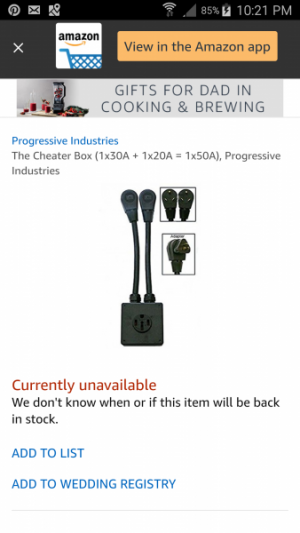- Joined
- Jul 18, 2017
- Messages
- 407
Hi guys,
So I am still in the process of selling woodworking equipment to make room for all my metalworking stuff in my 1 car garage. I picked up an Eastwood mg 135 welder (couldn't afford a Hobart or Miller). This welder supposedly can weld up to 3/16" mild steel, and it got good reviews. I should be content with that, however, like Tim Allen, I want more power (uhr, uhr, uhr)! I am a measly renter. What are my options for welding with more power so I can weld thicker steel? I would like to be a rebel to mig weld 1/2" mild steel and feel confident that the weld penetrated well enough. I could use a generator, I suppose. Is there anyway to power a welder with oart generator, part 20 amp wall outlet? The washer/dryer in my garage are on a regular 20 amp outlet. I also have a 15 amp outlet that is on my ceiling for my garage door opener. Can I use one of those RV cheater boxes to use a higher powered welder? Would it be dangerous to run a heavy duty extension cord from my kitchen's 20 amp gfci outlet by drilling a small hole to the garage, hook it up/combine with an adaptor to the 15 amp garage ceiling outlet, then plug into the 30 amp inlet to the cheater box with the washer/dryer outlet plugged into its 20 amp inlet so I can run a 50 amp welder? Here is a link to a site selling such a box:
https://www.pplmotorhomes.com/parts...MIx6Wz4cOT2wIVD9VkCh18Nw1nEAQYASABEgJPL_D_BwE

I know this idea sounds crazy, but it sounds like maybe it can work? This is why I am turning to you knowledgable guys - so I don't burn down my home.
Or could I weld 1/2" mild steel with what I have if I were to make a whole bunch multiple passes?
Thanks in advance to your kind, friendly constructive responses
Susan
So I am still in the process of selling woodworking equipment to make room for all my metalworking stuff in my 1 car garage. I picked up an Eastwood mg 135 welder (couldn't afford a Hobart or Miller). This welder supposedly can weld up to 3/16" mild steel, and it got good reviews. I should be content with that, however, like Tim Allen, I want more power (uhr, uhr, uhr)! I am a measly renter. What are my options for welding with more power so I can weld thicker steel? I would like to be a rebel to mig weld 1/2" mild steel and feel confident that the weld penetrated well enough. I could use a generator, I suppose. Is there anyway to power a welder with oart generator, part 20 amp wall outlet? The washer/dryer in my garage are on a regular 20 amp outlet. I also have a 15 amp outlet that is on my ceiling for my garage door opener. Can I use one of those RV cheater boxes to use a higher powered welder? Would it be dangerous to run a heavy duty extension cord from my kitchen's 20 amp gfci outlet by drilling a small hole to the garage, hook it up/combine with an adaptor to the 15 amp garage ceiling outlet, then plug into the 30 amp inlet to the cheater box with the washer/dryer outlet plugged into its 20 amp inlet so I can run a 50 amp welder? Here is a link to a site selling such a box:
https://www.pplmotorhomes.com/parts...MIx6Wz4cOT2wIVD9VkCh18Nw1nEAQYASABEgJPL_D_BwE

I know this idea sounds crazy, but it sounds like maybe it can work? This is why I am turning to you knowledgable guys - so I don't burn down my home.
Or could I weld 1/2" mild steel with what I have if I were to make a whole bunch multiple passes?
Thanks in advance to your kind, friendly constructive responses
Susan
